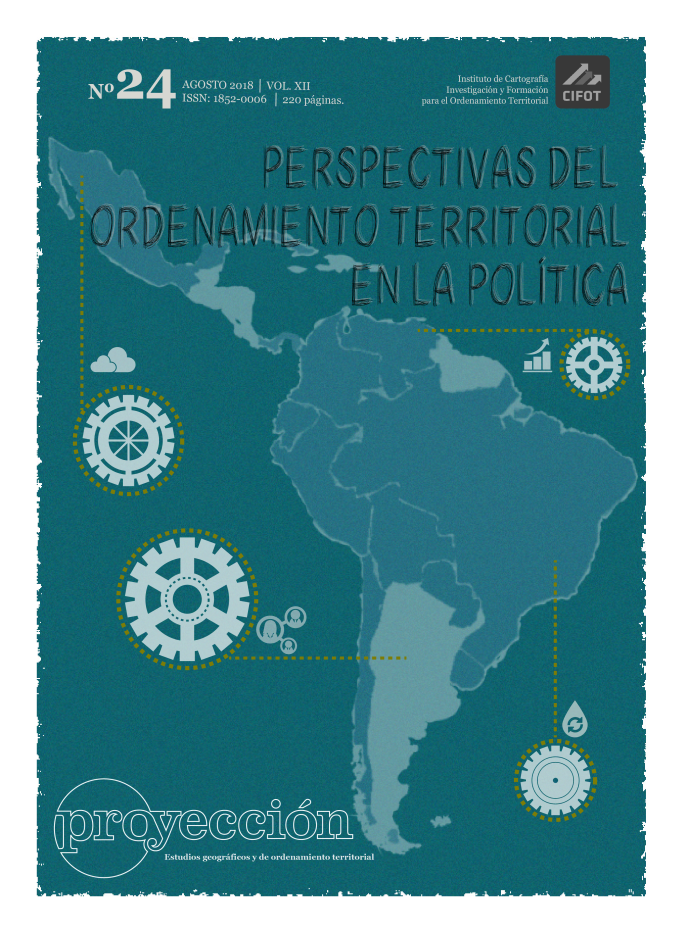Un desafío para el ordenamiento territorial: Gestión sustentable de la movilidad de cargas en circuitos productivos de oasis.
Palabras clave:
Movilidad, Circuitos productivos, Desarrollo, Dinámicas territoriales, PolíticasResumen
Ante el fuerte crecimiento poblacional actual, procesos de urbanización y exigencias de mercado no podemos considerar que las consecuencias que se derivan de sistemas de transporte mal planificados y desregularizados sean sólo económicas. El impacto del sistema de transporte colapsado actual refuerza el consumo energético, el impacto ambiental, las exclusiones socio espaciales, deteriora la calidad de vida, incrementa la accidentalidad, las pérdidas de espacio para los peatones y el deterioro del espacio público.
Las políticas de suelo y las políticas de transporte son una clave para desarrollo territorial. No son suficientes diagnósticos y estudios sobre gestión de la demanda de movilidad, ya que es el Estado el que debiera definir el perfil territorial, energético, económico y social de dichos modelos de transporte y determinar el impacto de la expansión económica y el desarrollo productivo en los circuitos de distribución y consumo, para la promoción y priorización de los medios de transporte más adecuados en cada caso.
El trabajo presenta un análisis crítico y una reflexión ante la crisis de los sistemas de transporte, a través de la identificación de organismos estatales con jurisdicción en el sector y los programas vigentes en materia de planificación. Se parte de la consideración de la complejidad sistémica del transporte de bienes y personas, que pone en evidencia la necesidad de un enfoque integral que considere todos los actores del sistema territorial y permanezca atento a las dinámicas de la comunidad, del territorio, del mercado y de los sistemas productivos. La ausencia de políticas y la planificación a corto plazo continúan incrementando exponencialmente las necesidades de desplazamiento de personas y bienes, los costos logísticos en los circuitos de consumo y el impacto ambiental por el consumo de combustibles fósiles.
Como resultado se identifican aspectos que se consideran fundamentales a revisar por las instituciones a cargo de la planificación, gestión, administración y regulación de los sistemas de transporte
Citas
CALONGE, F. (2014). Movilidades capitalistas e identidades subalternas. Te mueves porque te mueven.
CENTRO ESTRATÉGICO PARA EL CRECIMIENTO Y DESARROLLO ARGENTINO–CECREDA, EL SISTEMA DE TRANSPORTE EN ARGENTINA" Análisis de situación, problemáticas y propuestas para el Sistema de Transporte en Argentina
CEPAL (2015). Complejos productivos y territorio en la Argentina. Aportes para el estudio de la geografía económica del país.
EIZAGUIRRE GARAITAGOITIA, X. (2001). La construcción del territorio disperso. Talleres de reflexión sobre la forma difusa. Barcelona: Edicions Universitat Politècnica de Catalunya (upc).
GARCÍA, A. (2007). ¿Un nuevo ciclo para la planificación regional? El caso de seis economías regionales Argentinas. En Revista electrónica de geografía y ciencias sociales ISSN: 1138-9788.
GUILLEN, R. (2015). Inteligencia Estratégica: sistema de planificación y gestión ISBN 9789876940139. Buenos Aires.
GUTIÉRREZ, A. (2010). Movilidad, transporte y acceso: una renovación aplicada al ordenamiento territorial. En: Scripta Nova [En Línea]. Vol. XIV, No. 331 (86). Barcelona: Universidad Autónoma de Barcelona. Disponible en: www.ub.edu/geocrit/sn/sn-331/sn-331-86.htm
GUITIERREZ, A. (2012). ¿Qué es la movilidad? Elementos para (re)construir las definiciones básicas de transporte. En Revista Bitácora 21 Dossier Central, 63.
IAT (2015). Plan Federal Estratégico de Transporte. Lineamientos Generales.
CENECORTA, A. (2011). La necesidad de una política pública para el desarrollo de sistemas integrados de transporte en grandes ciudades mexicanas. Revista INVI, 26 (71), Pags 133-142. ISSN 0718-8358
ITDP México-Centro EURE. (2012). Planes Integrales de Movilidad: lineamientos para una movilidad urbana sustentable. México
LÓPEZ-GOYBURU, P. (2015). Miradas innovadoras sobre la interfaz urbano-rural: el plan de Extensión de Ámsterdam, los planes del Condado de Londres y del Gran Londres, y el plan Dedos de Copenhague. EURE (Santiago) [online]. 2017, vol.43, n.128, pp.175-196. ISSN 0250-7161. http://dx.doi.org/10.4067/S0250-71612017000100008
MADOERY, O. (2016). Los desarrollos latinoamericanos y sus controversias. - 1a ed. Ushuaia: Ediciones UNTDF.
NOZICA, G. (2014). Planificar para la integración territorial. Los escenarios deseables de inserción de la provincia de San Juan al MERCOSUR. En Revista Iberoamericana de Urbanismo nº6 Dossier
RAMÍREZ VELÁZQUEZ, B. (2009). Alcances y dimensiones de la movilidad: aclarando conceptos. Revista Ciudades Nº 82 Movilidad y transporte, Sección Ensayo, pag 3. México, Red de investigación urbana A.C. ISSN 0187-8611
SCHWEITZER, M (2011). La relación entre transporte y territorio. En Revista Voces en el Fénix. Año 2 No 9 ISSN 1853 8819 p. 26
YORY, C. (2007). Desarrollo territorial integrado, ciudad difusa y nuevas ruralidades. Consideraciones positivas para fortalecer el tema de la ciudad región en el diseño y revisión de los POT.
Descargas
Publicado
Cómo citar
Número
Sección
Licencia

Esta obra está bajo una licencia internacional Creative Commons Reconocimiento-NoComercial-CompartirIgual 3.0.
La revista Proyección establece las siguientes condiciones de publicación para los/as autores/as:
- Los/as autores/as conservan los derechos de autor y ceden a la revista el derecho de publicación bajo la Licencia Creative Commons Atribución-No Comercial-CompartirIgual 3.0 No portada (CC BY-NC-SA 3.0) que permite a terceros copiar, distribuir, exhibir y ejecutar la obra citando siempre la fuente y los datos de autoría según la norma prevista por la Revista Proyección. Esta licencia no permite el uso de la obra con fines comerciales.
- Todos los trabajos publicados por Proyección, Estudios Geográficos y de Ordenamiento Territorial serán bajo la modalidad de gratuidad para autores/as y lectores/as.




























